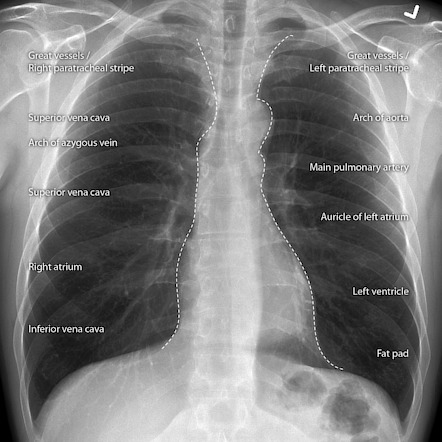

A fracture of the lateral masses of C2 would be visible on X-ray as a disruption of the C2 bony ring. Inside the body of C2, there is a radio-dense (“whiter”) ring of bone, which represents the lateral masses of C2. Make sure you include this in your scan of the cortices of each bone. The odontoid peg: as well as on the odontoid view, the peg can usually be viewed on lateral views as an increased area of density within the body of C1. If an abnormality is identified, you should note it and then continue to follow your systematic approach until all relevant bones have been assessed. A common pitfall is to stop searching once you have found one abnormality. In all three of the previously discussed views, you should carefully inspect the cortex (outer white edge) of each bone in turn, making sure you are systematic (e.g. A step in the lines, indicating a “Hangman’s fracture” – bilateral laminar and pedicle C2 fracture with anterolisthesis of C2 on C3 2 Bones Asymmetry of the space between the peg and the lateral mass of C1 may indicate fracture or dislocation of the odontoid peg.įigure 4. To do this, inspect and compare the space between the peg and the lateral mass of C1 on each side. You can also use this view to assess the odontoid peg to make sure it is aligned with the lateral masses of C1.

Irregularities in the areas where these lines intersect may indicate misalignment of the lateral masses of C1 and C2 (e.g. The odontoid/open-mouth view has several intersecting lines which are sometimes referred to as a “meeting of corners”. AP view C-spine X-ray with yellow (lateral) and blue (spinous process) lines added 1 Odontoid/open-mouth view The spinous process line runs down through each spinous process from C1 to C7 (represented by the blue line in the image below). The two lateral lines of the AP view run down either side of the vertebral bodies (represented by the yellow lines in the image below). The green channel is the space occupied by the spinal cord. Lateral cervical spine X-ray with red (spinolaminar), orange (posterior longitudinal) and yellow (anterior longitudinal) lines added. The spinolaminar line runs along the anterior edge of the spinous processes (at the junction of the spinous process and the laminae). The posterior longitudinal line runs along the posterior surface of the vertebral bodies. The anterior longitudinal line runs along the anterior surface of the vertebral bodies. There are multiple lines you need to assess across each of the three radiograph views which should run uninterrupted in healthy individuals. AdequacyĬheck the radiograph’s adequacy to ensure you are able to clearly see all relevant structures (you should be able to see from C1 down to the C7/T1 junction). If you are struggling to see down to the level of C7/T1, a fourth “ swimmer’s view” can be requested.Ī structured approach to cervical spine X-ray interpretation is discussed below. Typically there are three standard views provided when a cervical spine X-ray is performed, these include a lateral, antero-posterior (AP) and odontoid/open-mouth view. You might also be interested in our OSCE Flashcard Collection which contains over 2000 flashcards that cover clinical examination, procedures, communication skills and data interpretation.


 0 kommentar(er)
0 kommentar(er)
